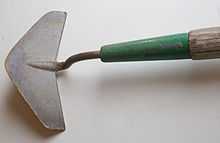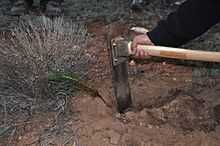Hoe (tool)
A hoe is an ancient and versatile agricultural tool used to move small amounts of soil. Common goals include weed control by agitating the surface of the soil around plants, piling soil around the base of plants (hilling), creating narrow furrows (drills) and shallow trenches for planting seeds and bulbs, to chop weeds, roots and crop residues, and even to dig or move soil, such as when harvesting root crops like potatoes.
Classes


There are two classes of hoe: pull or draw hoes; and push or thrust hoes, also called Dutch hoes.
A pull hoe has the blade set at approximately a right angle to the axis of the rod used as a handle. The user forces the blade into the ground with a downward chopping action and then pulls (draws) the blade towards them. Altering the angle of the handle can cause the hoe to dig deeper or more shallowly as the hoe is pulled. A pull hoe can easily be used manually to cultivate soil to a depth of several inches. It is not easy to use a pull hoe to cultivate and remove weeds etc. from only the surface layer of the soil.
A push hoe has a blade that must be set in a plane slightly upwardly inclined to the dual axis of the rod used as a handle stick. The user uses the handle to push the blade forward, forcing it below the surface of the ground and maintaining it at a shallow depth in the surface layer of soil by altering the angle of the handle whilst pushing. A push hoe can easily cultivate and remove weeds etc. from the surface layer of the soil. It is not easy to use a push an upward hoe manually to cultivate soil to a depth of more than a fraction of an inch. However a plastic handle allows for more maneuverability.
Types


There are many types of blades of quite different appearances and purposes. Some can perform multiple functions. Others are intended for a specific use. Types of hoes include:
- The collinear hoe has a narrow, razor-sharp blade which is used to slice weeds by skimming it just under the surface of the soil with a sweeping motion;[1] it is unsuitable for tasks like soil moving and chopping.
- The typical farming and gardening hoe with a heavy, broad delta-shaped blade and a flat edge is the Dego hoe.
- The Dutch hoe (scuffle, action, oscillating, swivel, or Hula-Ho) is a design that is pushed or pulled through the soil to cut weeds just under the surface. Its tool-head is a loop of flat, sharpened strap metal. It is not as efficient as a chopping hoe for pulling or pushing soil.
- Hoedads (also, "hoedags") are hoe-like tools used for planting trees.[2] According to Hartzell (1987, p. 29), "The hoedag [was] originally called skindvic hoe... Hans Rasmussen, legendary contractor and timber farm owner, is credited with having invented the curved, convex, round-nosed hoedag blade which is widely used today" (emphasis added).[3]
- Stirrup hoes are designed with a double edge blade that bends around to form a stirrup like rectangle attached to the handle. Weeds are cut just below the soil surface as the blade is pushed & pulled through the area. The back and forth motion is highly effective with cutting weeds in loose or breakable soil. Widths of the stirrup blade typically range between three to seven inches.
- The Swoe hoe is a modern[4] one-sided cutting hoe - a variant of the Dutch hoe.
- Wheel hoes are, as the name suggests, a hoe or pair of hoes attached to one or more wheels. The hoes are frequently interchangeable with other tools.[5]
- Others types include: tined hoes, sometimes called fork hoes or, when made for clam digging, clam hoes; and adze hoes, with the basic hoe shape but heavier and stronger and with traditional uses in trail making [6] and carpentry.
History
Hoes are an ancient technology, predating the plough and perhaps preceded only by the digging stick. In Sumerian mythology, the invention of the hoe was credited to Enlil, the chief of the council of gods.[7] The hand-plough (mr) was depicted in predynastic Egyptian art, and hoes are also mentioned in ancient documents like the Code of Hammurabi (ca. 18th century BC) and the Book of Isaiah (c. 8th century BC).
The human damage caused by long-term use of short-handled hoes, which required the user to bend over from the waist to reach the ground, and caused permanent, crippling lower back pain to farm workers, resulted in the California Supreme Court declaring the short-handled hoe to be an unsafe hand tool that was banned under California law in 1975.[8] The short-handled hoe that Governor Jerry Brown gave to César Chávez in 1975 was displayed in the California Hall of Fame in 2006.
-

'Mr' hand-plough, Protodynastic Period of Egypt (from the Scorpion Macehead)
-

Ancient Greek iron hoe (Kerameikos Archaeological Museum)
-

A 2000-year-old iron Roman hoe blade
-

Shennong the Divine Farmer (Han Dynasty, 2nd century)
-
Hilling
(Japanese Une 畝 )
for scallions, ploughed by rotary tiller or hoe (2007)
Archaeological use
Over the past fifteen or twenty years, hoes have become increasingly popular tools for professional archaeologists. While not as accurate as the traditional trowel, the hoe is an ideal tool for cleaning relatively large open areas of archaeological interest. It is faster to use than a trowel, and produces a much cleaner surface than an excavator bucket or shovel-scrape, and consequently on many open-area excavations the once-common line of kneeling archaeologists trowelling backwards has been replaced with a line of stooping archaeologists with hoes.
See also
Notes
- ↑ "Collinear Hoe Instructions" (PDF). Chelsea Green Publishing. 1995.
- ↑ Nix, Steve (May 28, 2008). "Hoedads: The Tool, The Cooperative". About.com.
- ↑ Hartzell, Hal Jr. (1987). Birth of a Cooperative: Hoedads, Inc. A Worker Owned Forest Labor Co-op. Eugene, OR: Hulogos'i Communications. p. 29. ISBN 0-938493-09-4.
- ↑ "Swoe". V&A Images.
- ↑ Power Farming. Power Farming, Incorporated. 1919. p. 191. Retrieved 10 July 2013.
- ↑ https://www.fhwa.dot.gov/environment/recreational_trails/publications/fs_publications/05232810/page09.cfm
- ↑ PBS. Heritage: Civilization and the Jews. "Nippur". Accessed 26 Nov 2012.
- ↑ "Fight in the Fields: Cesar Chavez and the Farmworkers' Struggle". Pbs.org. Retrieved December 13, 2012.
References
Further reading
- Evans, Chris, “The Plantation Hoe: The Rise and Fall of an Atlantic Commodity, 1650–1850,” William and Mary Quarterly, (2012) 69#1 pp 71–100.
External links
| Wikimedia Commons has media related to Hoes. |
- "Scuffle hoe" or "Dutch hoe" as defined by Memidex/WordWeb dictionary/thesaurus
| |||||||||||||||||||||||||||||||||||||
